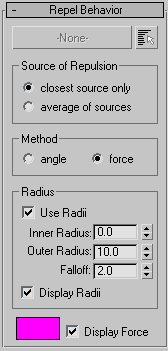 Command entry:
Command entry: 
Create panel


(Helpers)

Object Type rollout

Crowd

Setup rollout

Behaviors group

Click the New button.

Select Behavior Type dialog

Repel Behavior
 Command entry:
Command entry:Select a Crowd object.


Modify panel

Setup rollout

Behaviors group

Click the New button.

Select Behavior Type dialog

Repel Behavior
 Command entry:
Command entry:Select a Crowd object.


Modify panel

Setup rollout

Behaviors group

Choose Repel from the drop-down list.
The Repel behavior lets you specify any object or objects (sources) that will force delegates to move away from them. This
is basically the opposite of the Seek behavior. If you want delegates to back away from an object, as opposed to turning to face the direction they're moving, use Repel
in conjunction with the Orientation behavior.
NoteRepel is set by default to work only within a specific radius around the source. If you want it to work at any distance, turn
off Radius group

Use Radii.
Interface
- None (label)
-
Specifies a single source. Click this button, and then click the target object in the viewport. The target name then appears
on the button.
If you've selected multiple sources using Multiple Selection (see next item), the word Multiple appears on the button. To
see which objects are designated as sources, click the Multiple Selection button.
- Multiple Selection
-
Opens the Select dialog to let you designate multiple sources. When you have more than one source, you can set delegates to
move toward the closest target in the group, or to a computed average of the source positions.
Source of Repulsion group
Determines repel activity when the behavior uses multiple sources. The default choice is Closest Source Only.
- Closest Source Only
-
Each delegate is repelled by the closest of the assigned sources. Use this to have delegates assigned a single Repel behavior
move away from sources in different directions.
- Average Of Sources
-
All delegates move away from a common point determined by averaging all sources' locations.
Method group
Determines whether delegate direction as influenced by the behavior is calculated by an angular method or a force method.
Default=Force.
- Angle
-
Applies a force to the delegate based on the angle between the delegate's current direction and the direction it would need
to take in order to be moving directly away from the source.
The magnitude of the force is greatest when the delegate is moving directly towards the source, and needs to turn around.
It can be as little as 0 when the delegate is moving directly away from the source.
- Force
-
Always applies a force directly away from the source. The magnitude of the force is constant.
Radius group
Use the Radius settings to activate the Repel behavior only when the delegates are within a specific distance from the target.
The relative strength of the force increases from 0 percent at the outer radius to 100 percent at the inner radius.
- Use Radii
-
When on, the behavior applies only to delegates closer to the target than the Outer Distance value. Default=on.
- Inner Radius
-
The distance from the target at which the force is applied at full strength. Default=0.0.
- Outer Radius
-
The distance from the target at which the force begins to be applied. Default=10.0.
- Falloff
-
- Display Radii
-
The radii are displayed when the force is active.
_____
- Color Swatch
-
Shows the color used to draw the Repel force vector during the solution. Click the box to choose a different color. Default=violet.
- Display Force
-
When on, force exerted on the delegate(s) by the Repel behavior is drawn in the viewports as a vector during the simulation
solution.
 Command entry:
Command entry:  Create panel
Create panel 
 (Helpers)
(Helpers)  Object Type rollout
Object Type rollout  Crowd
Crowd  Setup rollout
Setup rollout  Behaviors group
Behaviors group  Click the New button.
Click the New button.  Select Behavior Type dialog
Select Behavior Type dialog  Repel Behavior
Repel Behavior
 Use Radii.
Use Radii.
